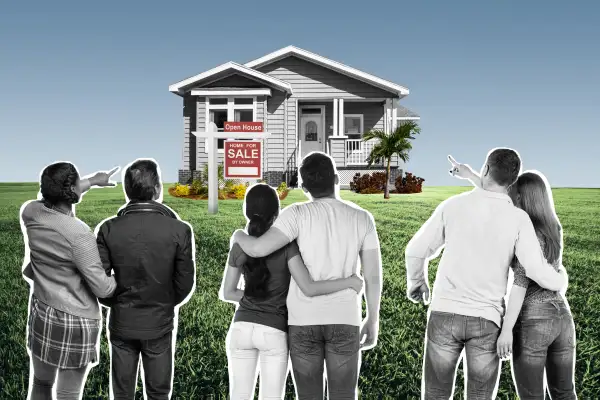The Latest Crop of Starter Homes Still Isn't Enough to Meet Overwhelming Demand

Over 1,900 starter homes hit the market in Tampa, Florida in August. That was 25% more entry-level listings than arrived in the same month last year and one of the largest annual jumps in the country. While all that new inventory should have offered relief to local first-time homebuyers — a group struggling with stiff competition and rising house prices since last spring, it wasn’t enough.
The city’s total active inventory is still down 28% compared to last year, and the starter-home sector? It’s “red-hot,” says Jeff Musgrave, an agent with Tampa’s The Musgrave Group. “There’s not enough for demand.”
Tampa’s not unique either. While the starter home situation may be improving in the Florida town, there’s a long way to go before supply meets sky-high demand or makes up for a historic drought of new home construction — and that’s true across most of the country.
Starter home supply is up — but so is the number of homebuyers
New listings were up in at least a third of major U.S. markets in September, and according to Realtor.com, the share of new starter home listings — those 1,750 square feet or smaller — increased notably over the last three months. In September alone, starter homes made up 42% of all newly listed single-family properties.
Still, these entry-level homes are hard to come by, and it’s thanks (at least in part) to rising demand. Much of this demand is from millennial homebuyers who, according to the National Association of Realtors, made up 37% of all buyers last year.
“We have millennials aging into their prime homebuying years, and that's a huge generation and a lot of people coming into the housing market,” says Nicole Bachaud, a market analyst for Zillow. “Many of them are buying their first home, which is most likely going to be in the starter home market.”
Also contributing to this uptick in starter-home demand? That’d be down-sizing baby boomers and renters seeking more space during the pandemic.
“Since the pandemic started, space and privacy have become the biggest priorities for buyers,” says Kris Lindahl, CEO and founder of Kris Lindahl Real Estate. “Many people decided they don’t want to live in apartments anymore.”
Meritage Homes, a homebuilder based in Scottsdale, Arizona, has seen its share of pandemic-spurred starter home demand. According to CEO Phillipe Lord, interest in Meritage’s entry-level properties has been “elevated” for 18 months now. In the second quarter of this year, starter homes comprised a whopping 81% of Meritage’s orders. Two years ago, starter homes were just 51% of the business.
“Home prices under $300,000 are the most sought-after price point in the U.S.,” Lord says. “Millennials and baby boomers are 80-plus million-strong combined and are both experiencing life events that typically precede the need for different dwellings.”
The inventory problem didn’t start with the pandemic
Though the pandemic has added to the country’s housing supply struggles — especially in the entry-level market, the imbalance between housing inventory and housing need isn’t new. In fact, the deep housing shortage began over a decade ago, during the housing crash of the late 2000s.
“At the end of the Great Recession, builders stopped building homes at the same level they had been before the housing bubble burst because real estate was seen as a little bit riskier, and there wasn't as much confidence in the future of housing,” Bachaud says. “They kind of paused building but then never picked it back up again. So COVID or not, we would have had a supply issue.”
According to the National Association of Home Builders, construction of entry-level homes has lagged significantly over the last 20 years. In 1999, homes under 1,800 square feet accounted for 37% of all new homes built. In 2020, it was just 25%. Freddie Mac estimates that today’s builders only produce about one-fifth of the entry-level homes they constructed in the ‘70s and ‘80s.
Rob Dietz, chief economist at NAHB, says builders need to produce about 100,000 additional entry-level homes annually to get back on track. In 2020, builders produced only about 229,000 starter home units, so that would mean increasing production by close to 50%.
Unfortunately, Dietz says, there are five major hurdles holding builders back, especially in the entry-level segment. He calls them the five Ls: lack of labor, lack of lots and land, lending constraints, lumber prices and, the biggest of all, legal and regulatory burdens.
“There are often exclusionary zoning practices, where a community will say, ‘You have to build on a half-acre lot. You can't build on a quarter-acre lot,’” Dietz says. “Well, if you have to build on a half-acre lot, you're more likely to have to build a larger, more expensive home, and you're going to build fewer of them.”
What starter-home buyers can expect
Despite all these headwinds, experts say listings will continue to increase as we head into the fall and on to 2022.
“We're going to continue to see slightly more inventory coming out to the market each month, so there should definitely be more options,” Bachaud says.
Both housing starts and building permits were up in August, indicating more new home supply is on its way. Additionally, lumber prices have decreased in recent months, falling from around $1,500 per 1,000 feet in May to just $500 in October. This easing of material costs could spur an additional uptick in activity from builders.
Will it be enough to solve all the market’s supply woes, though? Probably not. As Bachaud puts it, “It’s a pretty significant deficit.”
More from Money:
More Starter Homes Are Finally Hitting the Market
Frustrated House Hunters Are Giving up on Buying Only to Face an Expensive Rental Market
Fall Could Bring House Hunters Relief From More Than Just the Heat

